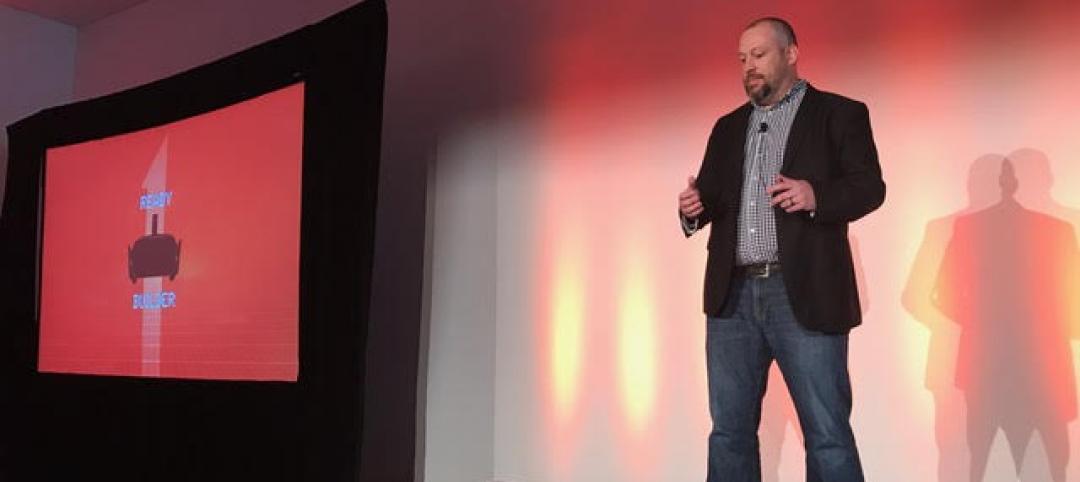Last month, I wrote about how automation and AI are dramatically changing all four fundamental relationships between buildings and machines. For example, nanotechnology, which manipulates individual atoms and molecules to assemble things, could make the modernist metaphor of a “machine for living in” into reality, since the building would actually be composed of many tiny machines.
In fact, that’s not quite accurate. The definition of “machine” is “an apparatus using or applying mechanical power and having several parts, each with a definite function and together performing a particular task.”
So machines are made of distinct parts, cobbled together to fulfill a function. They are characterized by their composition, as assemblages of singular bits and pieces in which the whole is greater than the sum.
SEE ALSO: Assessing AI's impact on the AEC profession and the built environment
But nanotech will completely change this. When entire buildings can be shaped from microscopic components, the visible distinction between the individual parts will evaporate. A structure built from invisible machines will not appear to be a machine at all, since it no longer will be perceived as an assembly of parts. An edifice made of congealed cybernetic butter will look to be all whole, no parts. The very concept of a “building” could become meaningless, since it will no longer be “built” in any traditional way.
Remember “Terminator 2”? Arnold Schwarzenegger’s T-800 is a machine: steel and servos wrapped in human skin. Robert Patrick’s T-1000 is made of liquid metal (“mimetic polyalloy”). He’s like sentient mercury, morphing into any shape he needs. A nanotech building (“nanotecture”?) would make conventional structures seem like Robby the Robot (of “Forbidden Planet” fame).
Buttery buildings could change everything we think and know about architecture. Frank Lloyd Wright felt that architectural form should stem from the inherent “nature” of its materials: “Each material speaks a language of its own.” In his mind, the proportions, heft, and texture of brick logically translated into structures such as the Robie House, which extends horizontally and hugs the land. But when the constituent parts of a building are too small to be seen with the naked eye, the relationships between form and materials will change. What is the “language” of a nanobot?
Because the character of a building could vary upon command—hard and opaque one minute, soft and transparent the next—the fabric of buildings could become fluid, fluctuating states from solid to liquid to gas and back. The notion of truth in materials will become irrelevant. In fact, the word material could go away. When the basic building blocks of architecture have no strict definition, structure and substance could separate. Matter may not matter.
Could there come a time when buildings will become less about bricks and mortar and feel more like mists or fogs, vaguely enveloping space in ways we can barely picture now? What will it be like to live in a cloud?
Lance Hosey, FAIA, LEED Fellow, is a Design Director with Gensler. His book, The Shape of Green: Aesthetics, Ecology, and Design, has been an Amazon #1 bestseller in the Sustainability & Green Design category.
Related Stories
| Jun 13, 2017
Accelerate Live! talk: A case for Big Data in construction, Graham Cranston, Simpson Gumpertz & Heger
Graham Cranston shares SGH’s efforts to take hold of its project data using mathematical optimization techniques and information-rich interactive visual graphics.
| Jun 13, 2017
Accelerate Live! talk: Scaling change in a changing industry, Chris Mayer, Suffolk Construction
Suffolk’s CIO Chris Mayer talks about the firm’s framework for vetting and implementing new technologies and processes.
| Jun 13, 2017
Accelerate Live! talk: Gaming tech in construction, Lucas Richmond, Gilbane
Learn why Gilbane’s Lucas Richmond is looking outside the AEC industry to build his rockstar gaming and media team.
| Jun 12, 2017
Accelerate Live! talk: The world's smartest buildings, Derik Eckhardt, Miller Hull Partnership
Discover what architect Derik Eckhardt learned during his worldwide tour of the globe’s smartest buildings, from Abu Dhabi to Amsterdam to Stuttgart to Dubai.
| Jun 12, 2017
Accelerate Live! talk: Preparing for the AI revolution, Alan Robles, Gensler
Gensler’s Alan Robles shares how the AEC Giant firm is preparing its project teams and clients for the coming artificial intelligence movement.
| May 24, 2017
Accelerate Live! talk: Applying machine learning to building design, Daniel Davis, WeWork
Daniel Davis offers a glimpse into the world at WeWork, and how his team is rethinking workplace design with the help of machine learning tools.
| May 24, 2017
Accelerate Live! talk: Learning from Silicon Valley - Using SaaS to automate AEC, Sean Parham, Aditazz
Sean Parham shares how Aditazz is shaking up the traditional design and construction approaches by applying lessons from the tech world.
| May 24, 2017
Accelerate Live! talk: The data-driven future for AEC, Nathan Miller, Proving Ground
In this 15-minute talk at BD+C’s Accelerate Live! (May 11, 2017, Chicago), Nathan Miller presents his vision of a data-driven future for the business of design.
AEC Tech | May 23, 2017
A funny thing may happen on the way to AI
As AI proves safe, big business will want to reduce overhead.
AEC Tech | May 11, 2017
Accelerate Live!: Social media reactions from BD+C's AEC innovation conference
BD+C's inaugural Accelerate Live! innovation conference took place May 11, in Chicago.









